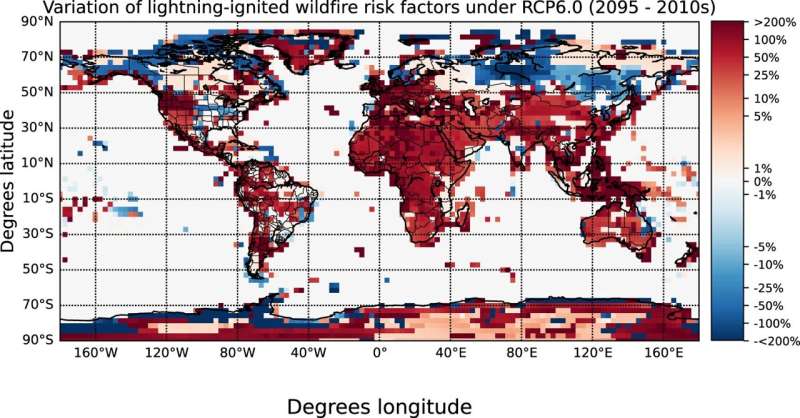March 1, 2023 report
This article has been reviewed according to Science X's editorial process and policies. Editors have highlighted the following attributes while ensuring the content's credibility:
fact-checked
peer-reviewed publication
trusted source
proofread
Global warming could lead to increase in 'hot lightning' strikes causing more wildfires

A combined team of Earth scientists from multiple institutions has found evidence that suggests that in the coming years, a warming planet could lead to more "hot lightning" strikes that could cause more wildfires in many parts of the world. In their paper published in the journal Nature Communications, the group describes studying the types of lightning strikes that lead to wildfires and the likelihood of their increase as global warming progresses.
The work began with an analysis of satellite images of U.S. wildfires over the years 1992 to 2018. By studying the types of lightning strikes that occurred and comparing them with resulting wildfires, the team found that wildfires are more likely to start due to hot lightning strikes, which the group describes as strikes that last much longer than average. They found that approximately 90% of the fires they observed got their start this way. Such strikes can last from around 40 milliseconds to nearly a third of a second. Longer strike times transfer more heat to flammable material such as trees, shrubs and even grass.
The researchers then looked at the rate of such lightning strikes over time. Computer simulations showed higher frequency as the atmosphere warms. And climate models showed that such strikes could increase from three strikes per second globally to four strikes per second. They note that the models also showed all types of lightning strikes increasing by 2090, representing a 28% increase.
The team then looked at which parts of the globe are most likely to see more hot lightning strikes as the planet warms and weather patterns change as a result. They found that parts of South America, Southeast Asia, Australia and Africa are all at risk. But they found the most dramatic increase will likely be in North America. On the other hand, the models showed that the polar regions are likely to see fewer wildfires as rain amounts will likely increase there.
More information: Francisco J. Pérez-Invernón et al, Variation of lightning-ignited wildfire patterns under climate change, Nature Communications (2023). DOI: 10.1038/s41467-023-36500-5
Journal information: Nature Communications
© 2023 Science X Network




















